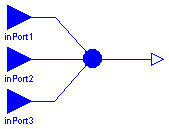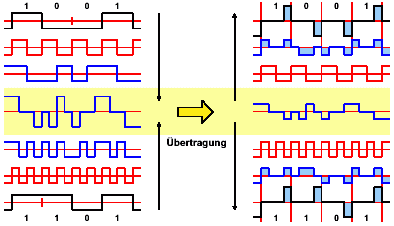[ASICs] [Chip Typen] [Chip Aufbau] [Entwicklung] [Schnittstellen] [Glossar]
[Buffer Types] [Interfaces] [Networks] [IEEE 802 Networks] [Data Lines] [Protocols] [Organazations]
[Line Codes] [Multiplexing] [Modulation] [Line Rates] [Encryption]
 Multiplexing
Multiplexing
The following page gives a rough overview about several multiplexing techniques. These describe how several independent data channels have access to a single physical signal carrier medium like copper cable, fiber optical cable or the air for wireless transmission systems. In general the multiplexing schemes are based upon time, frequency and code. Depending upon the scheme multiplexing is done before and/or after the channel coding and/or modulation.
CDMA Code Division Multiplex Access
COFDM Coded Orthogonal Frequency Division Multiplexing
FDMA Frequency Division Multiplex Access
OFDM Orthogonal Frequency Division Multiplexing
TDMA Time Division Multiplex Access
WCDMA Wide Band Code Division Multiple Access
SDMA Spatial Division Multiplex Access
![]()
CDMA Code Division Multiplex Access
CDMA refers to any of several protocols used in so-called second-generation (2G) and
third-generation (3G) wireless communications. CDMA is a form of multiplexing, allowing numerous signals to use a single transmission channel, optimizing the use of available bandwidth. The technology is
used in ultra-high-frequency (UHF) cellular telephone systems in the 800-MHz and 1.9-GHz bands.
CDMA employs analog-to-digital conversion (ADC) in combination with spread spectrum technology.
Audio input is first digitized into binary elements. The frequency of the transmitted signal is then made to vary according to a defined pattern (code), so it can be intercepted only by a receiver whose frequency
response is programmed with the same code. The CDMA channel is nominally 1.23 MHz wide. CDMA networks use a scheme called soft hand-off, which minimizes signal breakup as a handset
passes from one cell to another. The combination of digital and spread-spectrum modes supports several times as many  signals per unit bandwidth as analog modes. CDMA is compatible with other
cellular technologies which allows for nationwide Roaming.
signals per unit bandwidth as analog modes. CDMA is compatible with other
cellular technologies which allows for nationwide Roaming.
The original CDMA standard, also known as CDMA One and still common in cellular telephones in the US, offers a transmission speed
of only up to 14.4 Kbps in its single channel form and up to 115 Kbps in an eight-channel form. CDMA2000 and Wideband CDMA (WCDMA) deliver data
many times faster.
COFDM (Coded OFDM, Coded Orthogonal Frequency Division Multiplexing)
COFDM is an expansion of the already available OFDM modulation technique. The special
performance of COFDM with respect to multipath and interference, burst errors and fading are the reasons why COFDM is well-suited to the needs of terrestrial broadcasting channels. COFDM is
resistant to multipath effects because it uses multiple carriers to transmit the same signal. Thus COFDM has been choosen for the two standards DAB (Digital Audio Broadcast) and DVB-T (Digital Video
Broadcast-Terrestrial). COFDM is ideal for single frequency networks.
http://www.bbc.co.uk/rd/pubs/papers/pdffiles/ptrev_278-stott.pdf
FDMA Frequency Division Multiplex Access
FDMA is the division of the frequency band allocated for wireless cellular telephone communication into
30 channels, each of which can carry a voice conversation or, carry data of a digital service. FDMA is a basic technology in the analog Advanced Mobile Phone Service (AMPS), the most widely-installed
cellular phone system installed in North America. With FDMA, each channel can be assigned to only one user at a time. The Digital-Advanced Mobile Phone Service (D-AMPS) also uses FDMA but adds
time division multiple access (TDMA) to get three channels for each FDMA channel, tripling the number of calls that can be handled on a channel.
OFDM Orthogonal Frequency Division Multiplexing
OFDM is fundamentally different from other modulation schemes because it may be transmitted via
AM, FM, QAM (Quadrature Amplitude Modulation), and so on. OFDM is defined as a mathematically technique for the generation and demodulation of radio waves.
Frequency division multiplexing (FDM) is a technology that transmits multiple signals simultaneously over a single transmission path, such as a cable or wireless system. Each signal travels within its own unique frequency range (carrier), which is modulated by the data (text, voice, video, etc.). Orthogonal FDM's (OFDM) spread spectrum technique distributes the data over a large number of carriers that are spaced apart at precise frequencies. This spacing provides the "orthogonality" in this technique which prevents the demodulators from seeing frequencies other than their own. The benefits of OFDM are high spectral efficiency, resiliency to RF interference, and lower multi-path distortion. This is useful because in a typical terrestrial broadcasting scenario there are multipath-channels (i.e. the transmitted signal arrives at the receiver using various paths of different length).
The multicarrier transmission techniques OFDM is seen as a key technology for high-rate communications and is already part of the IEEE 801.11 and ETSI BRAN standard for wireless local area networks. OFDM became a serious alternative by applying modern, digital signal processing methods based on the Fast Fourier Transform (FFT). The main advantages are the high spectral efficiency, the simple channel equalization and the suppression of intersymbol interference. However OFDM suffers from a high peak-to-average power ratio of the transmitting signal. The unfavorable PAR prohibits power efficient operation of the amplifier which is especially intolerable in portable systems. Thus OFDM is not confined to mobile communications but is used in Digital Audio Broadcast (DAB), Digital Video Broadcast (DVB) and xDSL systems.
PAR === (crest factor, feed forward (digital) predistortion)
www.ofdm-forum.com
www.wave-report.com/tutorials/OFDM.htm
TDMA Time Division Multiplex Access
TDMA is a technology used in digital cellular telephone communication that divides each cellular channel
into time slots in order to increase the amount of data that can be carried.
TDMA is used by Digital-American Mobile Phone Service (D-AMPS), Global System for Mobile
communications (GSM), and Personal Digital Cellular (PDC). However, each of these systems implements TDMA in a somewhat different and incompatible way. An alternative multiplexing scheme to FDMA with TDMA is CDMA, which takes the entire allocated frequency range for a given service and
multiplexes information for all users across the spectrum range at the same time.
TDMA was first specified as a standard in EIA/TIA Interim Standard 54 (IS-54). IS-136, an evolved
version of IS-54, is the United States standard for TDMA for both the cellular (850 MHz) and personal communications services (1.9 GHz) spectrums. TDMA is also used for Digital Enhanced Cordless Telecommunications (DECT).
WCDMA Wide Band Code Division Multiple Access
WCDMA is an ITU standard and was derived from the CDMA standard. WCDMA is a
third-generation (3G) mobile wireless technology offering much higher data speeds to mobile and portable wireless devices than older technologies. WCDMA can support mobile/portable voice, images,
data, and video communications at up to 2 Mbps (local area access, no movement) or 384 Kbps (wide area access, movement in trains, cars, ...). The input signals are digitized and transmitted in coded,
spread-spectrum mode over a broad range of frequencies. A 5 MHz-wide carrier is used, compared with 200 kHz-wide carrier for narrowband CDMA.
SDMA Spatial Division Multiplex Access
SDMA has proven to be an interesting option for capacity increase of wireless communications systems.
The idea is to allow several users to use the same frequency band (and time slot) simultaneously and to identify them from their positions. SDMA makes use of antenna-array processing and advanced digital
signal processing techniques which rely heavily on concepts from linear algebra. The matrix decompositions involved are complex, mostly On3, with n the problem size. Moreover, data have to be
processed at a high rate (e.g. GSM 270 kbits/s), so that the computational requirement is in the Mflops/s or even Gflops/s range. Hence there is a strong need for efficient algorithms which can be
obtained by using adaptive matrix decomposition techniques.
[Home] [ASICs] [Selbstmanagement] [Inselmeer] [Spiele]
[Ich über mich] [Links] [SiteMap] [Disclaimer]